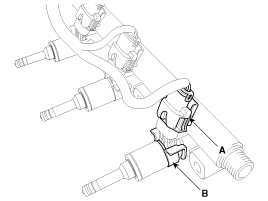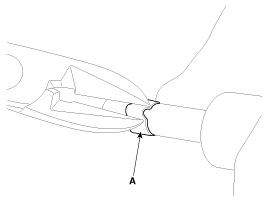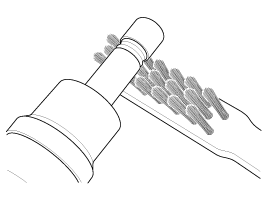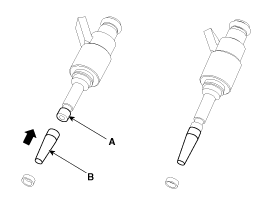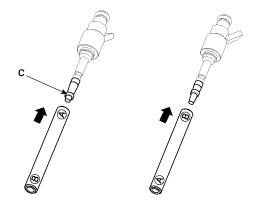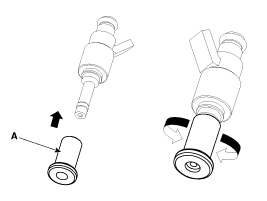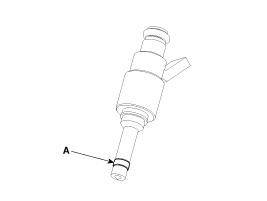 Hyundai Veloster: Injector. Repair procedures
Hyundai Veloster 2011-2017 Service Manual / Fuel System / Engine Control System / Injector. Repair procedures
Hyundai Veloster: Injector. Repair procedures
Hyundai Veloster 2011-2017 Service Manual / Fuel System / Engine Control System / Injector. Repair procedures
Inspection
| 1. |
Turn the ignition switch OFF.
|
| 2. |
Disconnect the injector connector.
|
| 3. |
Measure resistance between the injector terminals 1 and 2.
|
| 4. |
Check that the resistance is within the specification.
|
Removal
In case of removing the high pressure fuel pump, high pressure
fuel pipe, delivery pipe, and injector, there may be injury caused by
leakage of the high pressure fuel. So don’t do any repair work right
after engine stops.
|
| 1. |
Turn the ignition switch OFF and disconnect the battery negative
(-) cable.
|
| 2. |
Release the residual pressure in fuel line (Refer to “Release
Residual Pressure in Fuel Line” in this group).
|
| 3. |
Remove the delivery pipe & injector assembly (Refer to "Delivery
Pipe" in this group).
|
| 4. |
Remove the connector (A) and the fixing clip (B), and then separate
the injector from the delivery pipe.
|
Installation
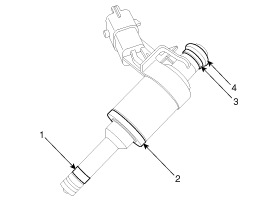
| 1. |
Combustion seal
|
| 2. |
Rubber washer
|
| 3. |
Support disc
|
| 4. |
O-ring
|
|
|
|
|
|
|
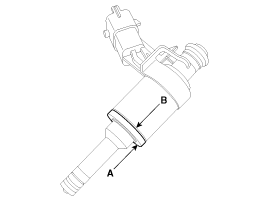
|
| 1. |
Installation is reverse of removal.
|
Replacement
| 1. |
Remove the combustion seal (A) with a wire cutter.
|
| 2. |
Before the assembly of the sealing ring the groove must be cleaned
using a clean cloth.
Any coking of the injector sealing surface must be carefully removed
with a brass-wire brush.
|
| 3. |
Place the seal installing guide (B) (SST No.: 09353-2B000) on
the tip of the injector not to damage the injector tip (A).
Push the sealing ring (C) with thumb and index finger over the
conical assembly tool until it snaps into the groove.
The complete assembly must not take longer than 2 to 3 seconds.
|
| 4. |
To size the sealing ring the injector is first introduced into
the sizing tool (A) (SST No.: 09353-2B000) and then pressed and at the
same time rotated 180° into the sizing tool.
|
| 5. |
Pull the injector out of the sizing tool by turning it in the
reverse direction to that used for the press-in process.
|
| 6. |
Check the combustion seal (A) installation.
|
 Injector. Schematic Diagrams
Injector. Schematic Diagrams
Circuit Diagram
...
 Purge Control Solenoid Valve (PCSV). Description and Operation
Purge Control Solenoid Valve (PCSV). Description and Operation
Description
Purge Control Solenoid Valve (PCSV) is installed on the surge tank and
controls the passage between the canister and the intake manifold. It is a solenoid
valve and is open when ...
See also:
Tire terminology and definitions
Air Pressure: The amount of air inside the tire pressing outward on the tire.
Air pressure is expressed in pounds per square inch (psi) or kilopascal (kPa).
Accessory Weight: This means the combine ...
Horn
To sound the horn, press the horn symbol on your steering wheel.
Check the horn regularly to be sure it operates properly.
✽ NOTICE
To sound the horn, press the area indicated by the horn ...
Camshaft Position Sensor (CMPS). Description and Operation
Description
Camshaft Position Sensor (CMPS) is a hall sensor and detects the camshaft
position by using a hall element.
It is related with Crankshaft Position Sensor (CKPS) and detects the ...
Categories
- Hyundai Veloster Manuals Home
- Hyundai Veloster 2010-2017 Owner's Manual
- Hyundai Veloster 2010-2017 Service Manual

